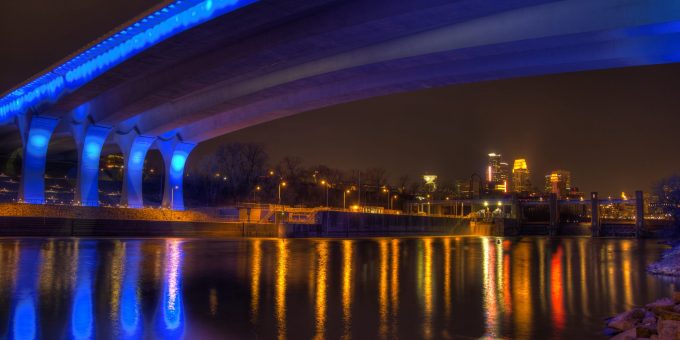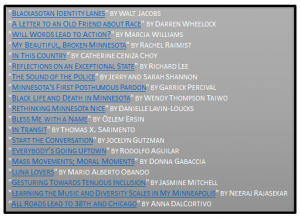
Today, The Society Pages reposts this original essay, written last summer as part of the Wonderful/Wretched series. Wonderful/Wretched is a collection of twenty-one essays on the racial dynamics of the Twin Cities written by social scientists with ties to the metro area in response to the killing of George Floyd. Wonderful/Wretched has since been revised and expanded in a published volume, Sparked: George Floyd, Racism, and the Progressive Illusion available through the Minnesota Historical Society. For the remainder of the summer, in celebration of Sparked’s publication, and in reflection of the year that has passed since last summer’s historic uprising for racial justice, The Society Pages will repost essays from Wonderful/Wretched in their original form.
Recently my 84 year-old father told me that he has vivid memories of hearing the news of Martin Luther King, Jr.’s assassination, even though it was 52 years ago. He remembers where he was (the White House Inn in downtown Charlotte, NC), what he was doing (finishing a late dinner with his White boss), and his initial reaction (asking the boss to go check on my mother, who was eight months pregnant with me while at home three hours away in Raleigh, NC; Dad thought that it would be dangerous for a White man to be in the area that was drawing a large crowd of angry African Americans). I frequently speak with my aunt (Dad’s sister), and the next time we chat I will ask her about her activities that day. I’m sure that she’ll also have strong memories of April 4, 1968, as MLK’s assassination was a formative event for members of her “Greatest Generation,” especially if they are African American.
A day that members of my generational cohort – Generation X – have seared into our consciousness is September 11, 2001. When the planes hit the New York City World Trade Center I was having a leisurely breakfast at a friend’s apartment. The friend was not there, as he had recently moved into his girlfriend’s house, but had not yet terminated his apartment lease. My apartment had been plastered and painted the day before following a leak from the unit upstairs, so I spent the night at the friend’s place to escape the fumes. In those days I never checked the news until I got to my office on the University of Minnesota’s Minneapolis campus, so when I arrived about an hour after flight 175 crashed into the World Trade Center south tower I was shocked when a former student relayed the news. I thought he was joking since the student was frequently flippant, but when my next door colleague ignored my “good morning” greeting at her door while she was glued to her computer screen I knew that something was up. It took 20 minutes or so for me to find a website that would load in heavy internet traffic, but after that I was also transfixed by the unfolding events. Six years later another tragedy occurred that generated memories that I’ll remember in my 80s, like my father. At 6:05 p.m. on August 1, 2007, the interstate I-35W bridge across the Mississippi River in downtown Minneapolis collapsed, killing 13 people. I was attending a screenwriting class several miles away in St. Paul. At our 7:00 break the instructor received news about the catastrophe, but we continued the class after a few students checked on relatives and learned that they were OK. I did not call my wife, as I knew that she was at home, and she knew that I was not anywhere near the bridge. Or so I thought until I got an earful when I got home. Valerie: “Why didn’t you check in?” Me: “You knew that I was going to class in the opposite direction from the bridge.” Valerie: “You expect me to remember that during a disaster this close to home?!” While not as far-reaching on the worldview-changing scale as September 11, 2001, August 1, 2007 did alter some of my everyday practices.May 25, 2020 may turn out to be another epochal day in the histories of Minneapolis, locally, and the United States of America, nationally. Indeed, the murder of George Floyd by a Minneapolis police officer and the subsequent global protests about police brutality and other injustices faced by Black people in the U.S. and other countries may lead to significant changes in race relations in the U.S. I wish that I had a time machine and could travel 20 years into the future to see if the summer of 2020 launched lasting cultural and policy changes.
In the meantime, I would like to thank all of the contributors to the Wonderful/Wretched Memories of Racial Dynamics in the Twin Cities, Minnesota special feature. To [in order of essay publication] Darren Wheelock, Marcia Williams, Rachel Raimist, Catherine Ceniza Choy, Richard Lee, Jerry and Sarah Shannon, Garrick Percival, Wendy Thompson Taiwo, Danielle Lavin-Loucks, Özlem Ersin, Thomas X. Sarmiento, Jocelyn Gutzman, Rodolfo Aguilar, Donna Gabacchia, Mario Alberto Obando, Jasmine Mitchell, Neeraj Rajasekar, and Anna DalCortivo: many thanks for educating us about the history and culture of the place at the epicenter of the most recent conflagration in the long history of racial discord in the United States.
A few months before the 2016 US presidential elections, Christopher S. Parker penned the article “Do Trump’s Racist Appeals Have a Silver Lining?” The subtitle: “Donald Trump’s undisguised bigotry has alienated vast blocs of voters, but at least it makes racism in America impossible to deny.” Parker concluded the article with a note about the potential positives of Trump’s rise to power:
In short, counter-intuitive as it may seem, Trump’s candidacy may be a good thing for the country. Ultimately, it may go a long way toward healing the racial divisions that have crippled this nation from its founding. With the recognition of the depth of racism in America should come support for policies designed to at least mitigate, if not eliminate, the effects of discrimination. This is a net good. The discerning reader, however, will note that this analysis refers only to Trump’s candidacy-not to a Trump presidency. The former, we’ll likely weather. The latter would likely mean the end of America as we know it. But that’s a story for another day.
Four years later Washington Post columnist Dana Millbank revisited Parker’s article with the July 3, 2020 column, “A massive repudiation of Trump’s racist politics is building.” As Parker predicted, the America many people know in 2020 is not the same as the America they perceived in 2016. Millbank informs us that Parker now thinks that a backlash Trump has provoked among Whites, Blacks, and other people of color could lead to a second Reconstruction. “I know it sounds crazy, especially coming from a Black man,” Millbank quotes Parker, but “I think Trump actually is one of the best things that’s happened in this country.”
I don’t think I can go as far as saying that the current occupant of the White House is one of the best things in United States history, but perhaps the many individual and group protests about our currently wretched state of affairs will eventually be regarded as kicking off a more wonderful future. As we have seen in the essays in the Wonderful/Wretched Memories of Racial Dynamics in the Twin Cities, Minnesota series, racial identities and racialized interactions are messy and fraught with inequities, but there are also opportunities to build a more democratic and just future. In the year 2040, perhaps, we’ll look back 20 years to May 25, 2020 as a significant turning point not only in Black people’s efforts to obtain social justice, but it may also have been the start of improved life outcomes for other people of color too. Let’s hope so.
Oakland, CA
July 17, 2020
Epilogue: August 5, 2020.
I subscribe to “The Atlantic Daily” newsletter from The Atlantic magazine. Today’s edition arrived with a link to a new essay by Ibram X. Kendi, “Is This the Beginning of the End of American Racism?” The arguments in this essay mirror those of Christopher S. Parker’s “Do Trump’s Racist Appeals Have a Silver Lining?” Kendi notes, “[Trump] has held up a mirror to American society, and it has reflected back a grotesque image that many people had until now refused to see: an image not just of the racism still coursing through the country, but also of the reflex to deny that reality. Though it was hardly his intention, no president has caused more Americans to stop denying the existence of racism than Donald Trump.” Kendi muses further: “And just as the 1850s paved the way for the revolution against slavery, Trump’s presidency has paved the way for a revolution against racism.” In the essay’s concluding section, Kendi states that Americans can take one of two paths:
One path forward leads to a mere restoration. Barack Obama’s vice president unseats Trump, removing the bad apple from the barrel. With Trump dispatched, the nation believes it is again headed in the right direction. On this path, Americans consider racism to be a significant problem. But they deny the true gravity of the problem and the need for drastic action.
Or Americans can realize that they are at a point of no return. No returning to the bad old habit of denial. No returning to cynicism. No returning to normal—the normal in which racist policies, defended by racist ideas, lead to racial inequities. On this path, Trump’s denialism has permanently changed the way Americans view themselves. The Trump effect is real, and lasting. The reckoning we have witnessed this spring and summer at public demonstrations transforms into a reckoning in legislatures, C-suites, university admissions offices.
Which path will we take?
Return to the Wonderful/Wretched Series introduction.
Link to purchase Sparked: George Floyd, Racism, and the Progressive Illusion

